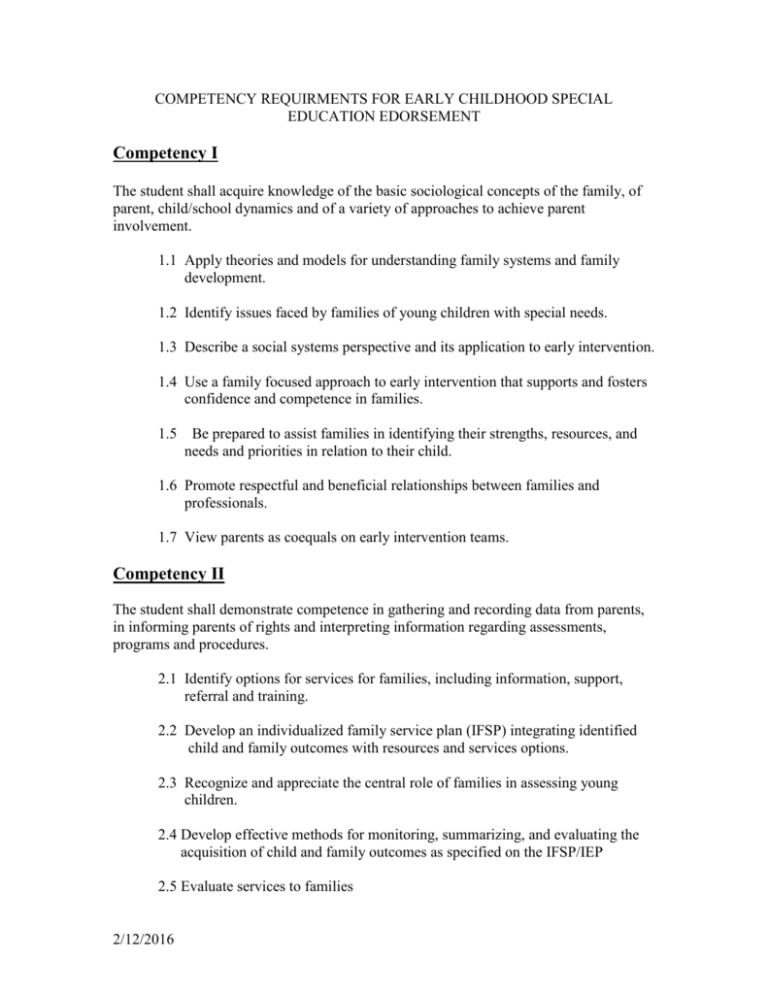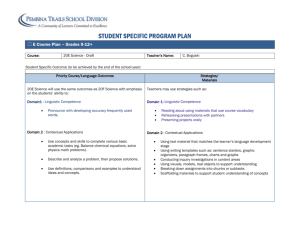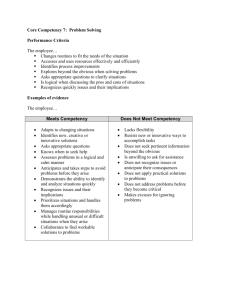Competency I
advertisement

COMPETENCY REQUIRMENTS FOR EARLY CHILDHOOD SPECIAL EDUCATION EDORSEMENT Competency I The student shall acquire knowledge of the basic sociological concepts of the family, of parent, child/school dynamics and of a variety of approaches to achieve parent involvement. 1.1 Apply theories and models for understanding family systems and family development. 1.2 Identify issues faced by families of young children with special needs. 1.3 Describe a social systems perspective and its application to early intervention. 1.4 Use a family focused approach to early intervention that supports and fosters confidence and competence in families. 1.5 Be prepared to assist families in identifying their strengths, resources, and needs and priorities in relation to their child. 1.6 Promote respectful and beneficial relationships between families and professionals. 1.7 View parents as coequals on early intervention teams. Competency II The student shall demonstrate competence in gathering and recording data from parents, in informing parents of rights and interpreting information regarding assessments, programs and procedures. 2.1 Identify options for services for families, including information, support, referral and training. 2.2 Develop an individualized family service plan (IFSP) integrating identified child and family outcomes with resources and services options. 2.3 Recognize and appreciate the central role of families in assessing young children. 2.4 Develop effective methods for monitoring, summarizing, and evaluating the acquisition of child and family outcomes as specified on the IFSP/IEP 2.5 Evaluate services to families 2/12/2016 Competency III The student shall demonstrate knowledge of typical child development and the factors that result in atypical child development. 3.1 Demonstrate an understanding of theories of child development, including theories of organization of development across domains and interaction between biology and environment. 3.2 Identify characteristics of social and physical contexts influencing development and learning. 3.3 Demonstrate an understanding of prenatal development and birth. 3.4 Identify the sequences, characteristics, and interrelationships in development across domains. 3.5 Demonstrate an understanding of play and its role in development. 3.6 Apply theoretical and research models regarding interactions between disabling conditions, risk factors, environments, and development in planning a program. 3.7 Identify biological, genetic, medical, and environmental factors that place the young child at risk. 3.8 Identify the etiology and symptomatology of common developmental disabilities or conditions in young children. Competency IV The student shall demonstrate competence in applying typical and atypical child development knowledge to curriculum, identification and expected development decisions. 4.1 Demonstrate an understanding of the scope and sequence of intervention curricula and methods for teaching infants/toddlers/ and preschoolers with specific disabilities. 4.2 Develop lesson plans that incorporate methods for providing individual and group intervention using a variety of methods. 4.3 Develop lesson plans that integrate knowledge and strategies from multiple disciplines in design and implementation of intervention activities. 2/12/2016 4.4 Identify a range of models of early intervention with varying philosophical bases. 4.5 Identify characteristics of environmental and instructional strategies that facilitate development, learning and independence in infants, toddlers, and preschoolers. Competency V The student shall demonstrate knowledge of program and service delivery alternatives. 5.1 Describe the professional roles on early intervention teams, including medical, social service, and educational roles. 5.2 Identify models and issues in service delivery in medical, social service, and educational settings. 5.3 Identify the functions of early intervention teams as determined by mandates and service delivery needs of children/families. 5.4 Identify models of multidisciplinary, interdisciplinary and transdisciplinary team process as it applies within and between service settings. 5.5 Demonstrate an understanding of the structure supporting interagency collaboration including interagency agreements, referral, consultation. 5.6 Identify strategies for team building. 5.7 Explain the dynamics of team roles, interaction, communication, problem solving, and conflict resolution. 5.8 Demonstrate ability to evaluate and design processes and strategies for supporting transitions. Competency VI The student shall demonstrate competence in identifying, writing, implementing and communicating educational outcomes/goals with parents and other professionals based upon assessment data and individual needs. 6.1 Demonstrate an understanding of the central roles of families in assessment. 6.2 Demonstrate the development of IFSP/IEP in partnership with family members, and incorporating both child and family outcomes/goals, objectives/strategies. 2/12/2016 6.3 Write goals for supporting and facilitating family/child interactions as primary contexts for learning and development in infants,/toddlers/ preschoolers. Competency VII The student shall demonstrate knowledge of language acquisition and development within the instructional setting. 7.1 Explain theoretical models describing the development of communication. 7.2 Demonstrate an understanding of the biological and environmental factors contributing to communication development. 7.3 Identify the implication of disability on typical development of communication skills. 7.4 Explain the affect of language and communication development upon other developmental domains of the child. Competency VIII The student shall demonstrate competence in developing appropriate instructional procedures within the instructional setting for language development using motor, language, self help, emotional and cognitive skills. I 8.1 Develop a curriculum that includes the scope and sequence of developmental intervention curricula for infants/ toddlers/ preschoolers across all areas of development and learning including language/ communication, sensorimotor, cognitive, emotional, social and motor. Competency IX The student shall demonstrate competence in the selection, administration, scoring, interpretation and reporting of assessment activities 9.1 Identify the functions of various assessment activities in early intervention including child find, screening, diagnosis assessment, educational assessment, and monitoring progress in intervention. 9.2 Describe the options for data collection appropriate for different assessment functions including open and focused observation, norm-referenced tests, criterion-referenced checklists and ordinal sales. 2/12/2016 9.3 Explain the limitation of administration and interpretation of normreferenced instruments used to assess young children with special needs. 9.4 Describe a range of typical norm-referenced, criterion referenced, and ordinal measures utilized in early intervention settings for various functions. 9.5 When necessary, apply approaches for observing child/environment interactions. 9.6 Explain approaches for observing child/other interactions. 9.7 Adapt assessments as necessary for specific sensory and motor impairments. 9.8 Administer and interpret at least one of the following types of instruments (screening, developmental assessment, informant interview, behavior rating, etc.) 9.9 Design an assessment battery and process for purposes of collecting information for decision making and instructional planning. Competency X The student shall demonstrate competence in the utilization and application of assessment data for child identification, program analysis, refinement and development and parental understanding. 10.1 Summarize and integrate assessment information into implications and recommendations for content and process intervention. 10.2 Develop an IEP/IFSP in partnership with family members incorporating both child and family goals and approaches. Competency XI The student shall demonstrate competence in the use of due process procedures for the young child with a disability and family. 11.1 Describe the development and responsibilities of teams in providing services for young children and families. 2/12/2016 11.2 Describe the processes involved in identification and programming for young children with special needs. 11.3 Explain the historical, philosophical and legal basis of special education. 11.4 Identify current trends and issues in special education. 11.5 Describe the legal basis of early childhood special education, including supporting federal and state legislation and litigation. 11.6 Identify ethical and policy issues related to education social service, and medical intervention with young children and their families. 2/12/2016









